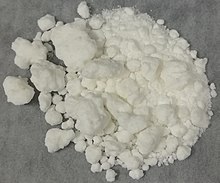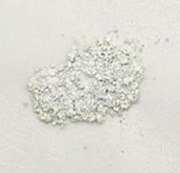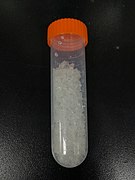Ytterbium compounds
Ytterbium compounds are chemical compounds that contain the element ytterbium (Yb). The chemical behavior of ytterbium is similar to that of the rest of the lanthanides. Most ytterbium compounds are found in the +3 oxidation state, and its salts in this oxidation state are nearly colorless. Like europium, samarium, and thulium, the trihalides of ytterbium can be reduced to the dihalides by hydrogen, zinc dust, or by the addition of metallic ytterbium.[1] The +2 oxidation state occurs only in solid compounds and reacts in some ways similarly to the alkaline earth metal compounds; for example, ytterbium(II) oxide (YbO) shows the same structure as calcium oxide (CaO).[1]
Halides

Ytterbium forms both dihalides and trihalides with the halogens fluorine, chlorine, bromine, and iodine. The dihalides are susceptible to oxidation to the trihalides at room temperature and disproportionate to the trihalides and metallic ytterbium at high temperature:[1]
Some ytterbium halides are used as reagents in organic synthesis. For example, ytterbium(III) chloride (YbCl3) is a Lewis acid and can be used as a catalyst in the Aldol[2] and Diels–Alder reactions.[3] Ytterbium(II) iodide (YbI2) may be used, like samarium(II) iodide, as a reducing agent for coupling reactions.[4] Ytterbium(III) fluoride (YbF3) is used as an inert and non-toxic tooth filling as it continuously releases fluoride ions, which are good for dental health, and is also a good X-ray contrast agent.[5]
Oxides
Ytterbium reacts with oxygen to form ytterbium(III) oxide (Yb2O3), which crystallizes in the "rare-earth C-type sesquioxide" structure which is related to the fluorite structure with one quarter of the anions removed, leading to ytterbium atoms in two different six coordinate (non-octahedral) environments.[6] Ytterbium(III) oxide can be reduced to ytterbium(II) oxide (YbO) with elemental ytterbium, which crystallizes in the same structure as sodium chloride.[1]
Borides
Ytterbium dodecaboride (YbB12) is a crystalline material that has been studied to understand various electronic and structural properties of many chemically related substances. It is a Kondo insulator.[7] It is a quantum material; under normal conditions, the interior of the bulk crystal is an insulator whereas the surface is highly conductive.[8] Among the rare earth elements, ytterbium is one of the few that can form a stable dodecaboride, a property attributed to its comparatively small atomic radius.[9]
Other inorganic compounds

Ytterbium(III) nitrate is the nitrate of ytterbium in the +3 oxidation state.[10] The compound forms colorless crystals, dissolves in water, and also forms crystalline hydrates.[11][12] It can be obtained by reacting ytterbium and nitric oxide in ethyl acetate:
- Yb + 3 N2O4 → Yb(NO3)3 + 3 H2O
Ytterbium phosphide is the phosphide of ytterbium in the +3 oxidation state.[13][14][15] It can be obtained by reacting ytterbium and phosphine in liquid ammonia to form Yb(PH2)2·5NH3, which can be decomposed to obtain ytterbium phosphide:[16]
- Yb(PH2)2•5NH3 → Yb(PH2)2 + 5NH3
- 2Yb(PH2)2 → YbP + 2PH3 + H2
The compound forms black crystals of a cubic system, space group Fm3m.[17]
Ytterbium(III) acetate is an acetate of ytterbium in the +3 oxidation state. It has colorless crystals that are soluble in water and can form hydrates.[18][19] Ytterbium acetate can be used as a raw material for the synthesis of upconversion luminescent materials;[20] it can also be used as a catalyst for some specific organic reactions.[21]
Alloys
Ytterbium dirhodium disilicide
Ytterbium dirhodium disilicide (YbRh2Si2), also abbreviated YRS, is a heavy fermion solid state compound of ytterbium, rhodium and silicon. It becomes superconducting when cooled to 2 mK. Just above this temperature the heat capacity is extremely high, and the electrons behave as if they were 1,000,000 times heavier than they really are.[22] The valence of Yb depends on temperature and magnetic field.[23]
Ytterbium-bismuth-platinum
Ytterbium-bismuth-platinum is an intermetallic material which at low temperatures exhibits an extremely high value of specific heat, which is a characteristic of heavy-fermion behavior. Ytterbium-bismuth-platinum has a noncentrosymmetric cubic crystal structure; in particular it belongs to the ternary half-Heusler compounds.
Ytterbium-gallium-germanium
Ytterbium-gallium-germanium (also called YbGaGe) is an alloy of ytterbium, gallium and germanium. It sparked interest because one group of researchers reported that it exhibits zero thermal expansion, while being conductive.[24] Such materials have applications in space and other environments where low thermal expansion materials are required.[25] However, subsequent measurements by other groups were not able to reproduce those results, but rather found expansion coefficients similar to copper.[26]
Pictures of ytterbium compounds
-
Ytterbium(III) sulfide (Yb2S3)
-
Ytterbium(II) chloride (YbCl2)
-
Ytterbium(III) chloride (YbCl3)
-
Ytterbium(III) nitrate (Yb(NO3)3)
-
Ytterbium(III) acetate (Yb(CH3COO)3)
-
Ytterbium(III) acetate tetrahydrate (Yb(CH3COO)3·4H2O)
-
Ytterbium(III) hydroxide (Yb(OH)3)
-
Ytterbium(III) oxide (Yb2O3)
See also
References
- ^ a b c d Holleman, Arnold F.; Wiberg, Egon; Wiberg, Nils (1985). "Die Lanthanoide". Lehrbuch der Anorganischen Chemie (in German) (91–100 ed.). Walter de Gruyter. pp. 1265–1279. ISBN 978-3-11-007511-3.
- ^ Lou, S.; Westbrook, J. A.; Schaus, S. E. (2004). "Decarboxylative Aldol Reactions of Allyl β-Keto Esters via Heterobimetallic Catalysis". Journal of the American Chemical Society. 126 (37): 11440–11441. doi:10.1021/ja045981k. PMID 15366881.
- ^ Fang, X.; Watkin, J. G.; Warner, B. P. (2000). "Ytterbium Trichloride-Catalyzed Allylation of Aldehydes with Allyltrimethylsilane". Tetrahedron Letters. 41 (4): 447. doi:10.1016/S0040-4039(99)02090-0.
- ^ Girard, P.; Namy, J. L.; Kagan, H. B. (1980). "Divalent Lanthanide Derivatives in Organic Synthesis. 1. Mild Preparation of Samarium Iodide and Ytterbium Iodide and Their Use as Reducing or Coupling Agents". Journal of the American Chemical Society. 102 (8): 2693. doi:10.1021/ja00528a029.
- ^ Enghag, Per (2004). Encyclopedia of the elements: technical data, history, processing, applications. John Wiley & Sons, ISBN 978-3-527-30666-4, p. 448.
- ^ Wells A.F. (1984) Structural Inorganic Chemistry 5th edition, Oxford Science Publications, ISBN 0-19-855370-6
- ^ Al'tshuler, T. S.; Bresler, M. S. (2002). "On the nature of the energy gap in ytterbium dodecaboride YbB12". Physics of the Solid State. 44 (8): 1532–1535. Bibcode:2002PhSS...44.1532A. doi:10.1134/1.1501353. S2CID 120575196.
- ^ Xiang, Z.; Kasahara, Y.; Asaba, T.; Lawson, B.; Tinsman, C.; Chen, Lu; Sugimoto, K.; Kawaguchi, S.; Sato, Y.; Li, G.; Yao, S.; Chen, Y. L.; Iga, F.; Singleton, John; Matsuda, Y.; Li, Lu (2018). "Quantum oscillations of electrical resistivity in an insulator". Science. 362 (6410): 65–69. arXiv:1905.05140. Bibcode:2018Sci...362...65X. doi:10.1126/science.aap9607. PMID 30166438. S2CID 206664739.
- ^ La Placa, 1 S. J.; Noonan, D. (1963). "Ytterbium and terbium dodecaborides". Acta Crystallographica. 16 (11): 1182. doi:10.1107/S0365110X63003108.
{{cite journal}}: CS1 maint: numeric names: authors list (link) - ^ Лидин, Ростислав; Молочко, Вадим; Андреева, Лариса (2 February 2019). Константы неорганических веществ. Справочник (in Russian). Litres. p. 69. ISBN 978-5-04-077039-7. Retrieved 19 August 2021.
- ^ "Ytterbium(III) nitrate pentahydrate". Sigma Aldrich. Retrieved 19 August 2021.
- ^ Edelmann, Frank T.; Herrmann, Wolfgang A. (14 May 2014). Synthetic Methods of Organometallic and Inorganic Chemistry, Volume 6, 1997: Volume 6: Lanthanides and Actinides. Georg Thieme Verlag. p. 23. ISBN 978-3-13-179221-1. Retrieved 19 August 2021.
- ^ "Ytterbium Phosphide". American Elements. Retrieved 21 December 2021.
- ^ Shur, Michael S.; Levinshtein, Michael E. (8 December 1995). Best Of Soviet Semiconductor Physics And Technology (1989-1990). World Scientific. p. 384. ISBN 978-981-4502-62-7. Retrieved 21 December 2021.
- ^ Toxic Substances Control Act (TSCA) Chemical Substance Inventory. U.S. Government Printing Office. 1979. p. 90. Retrieved 21 December 2021.
- ^ Pytlewski, L. L.; Howell, J. K. (1 January 1967). "Preparation of Europium and ytterbium phosphides in liquid ammonia". Chemical Communications (24): 1280. doi:10.1039/C19670001280. Retrieved 21 December 2021.
- ^ "mp-2390: YbP (cubic, Fm-3m, 225)". materialsproject.org. Retrieved 21 December 2021.
- ^ Никольский Б.П. и др., ed. (1971). Справочник химика. Vol. 2 (3-е изд., испр ed.). Л.: Химия.
- ^ CRC Handbook of Chemistry and Physics (89th ed.). Taylor and Francis Group, LLC. 2008.
- ^ Joseph K. Marsh (1943-01-01). "4. Rare-earth metal amalgams. Part III. The separation of ytterbium from its neighbours". Journal of the Chemical Society (Resumed): 8–10. doi:10.1039/JR9430000008. ISSN 0368-1769. Archived from the original on 2018-06-11. Retrieved 2019-02-01.
- ^ Tan, Xuefeng; Wang, Yue; Li, Jianguo; Hu, Xiaojia; Wang, Gongying. Methoxycarbonylation of Isophorondiamine Catalyzed by Ytterbium Acetate. Shiyou Huagong (Petrochemical Technology), 2012, 41 (9): 1011-1016. doi:10.3969/j.issn.1000-8144.2012.09.005
- ^ "Heavy fermions get nuclear boost on way to superconductivity". Phys.org. 28 January 2016. Retrieved 29 January 2016.
- ^ Stefan Engel, Elias C. J. Gießelmann, Maximilian K. Reimann, Rainer Pöttgen, and Oliver Janka. On the Ytterbium Valence and the Physical Properties in Selected Intermetallic Phases. ACS Org. Inorg. Au, 2024. doi:10.1021/acsorginorgau.3c00054.
- ^ Salvador, James R; Guo, Fu; Hogan, Tim; Kanatzidis, Mercouri G (2003). "Zero thermal expansion in YbGa Ge due to an electronic valence transition". Nature. 425 (6959): 702–705. Bibcode:2003Natur.425..702S. doi:10.1038/nature02011. PMID 14562099. S2CID 4412282.
- ^ "Zero Expansion Conductor". October 20, 2003. p. 1. Retrieved May 23, 2011.
- ^ Janssen, Y; Chang, S; Cho, B. K; Llobet, A; Dennis, K. W; McCallum, R. W; Mc Queeney, R. J; Canfield, P. C (2004). "YbGaGe: Normal thermal expansion". arXiv:cond-mat/0407683.









